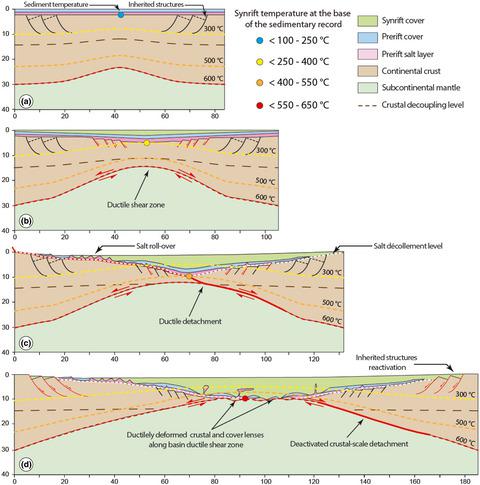当前位置:
X-MOL 学术
›
Basin Res.
›
论文详情
Our official English website, www.x-mol.net, welcomes your
feedback! (Note: you will need to create a separate account there.)
Review of Iberia–Eurasia plate‐boundary basins: Role of sedimentary burial and salt tectonics during rifting and continental breakup
Basin Research ( IF 2.8 ) Pub Date : 2020-12-08 , DOI: 10.1111/bre.12529 Nicolas Saspiturry 1 , Benoit Issautier 2 , Philippe Razin 1 , Thierry Baudin 2 , Riccardo Asti 3 , Yves Lagabrielle 3 , Cécile Allanic 2 , Olivier Serrano 2 , Thibault Duretz 2
Basin Research ( IF 2.8 ) Pub Date : 2020-12-08 , DOI: 10.1111/bre.12529 Nicolas Saspiturry 1 , Benoit Issautier 2 , Philippe Razin 1 , Thierry Baudin 2 , Riccardo Asti 3 , Yves Lagabrielle 3 , Cécile Allanic 2 , Olivier Serrano 2 , Thibault Duretz 2
Affiliation

|
We document the role of sedimentary burial and salt tectonics in controlling the deformation style of continental crust during hyperextension. The Iberian‐European boundary records a complex history of Cretaceous continental extension, which has led to the development of so‐called smooth‐slope type basins. Based on the review of the available geological constraints (crustal‐balanced cross‐sections, sedimentary profile evolution, RSCM thermometer, low‐temperature thermochronology) and geophysical data (Bouguer anomaly, Moho depth, seismic reflection profiles and Vp/Vs velocity models) on the Tartas, Arzacq, Cameros, Parentis, Columbrets, Mauléon, Basque‐Cantabrian and Internal Metamorphic Zone basins, we shed light on the main characteristics of this type of basin. This synthesis indicates that crustal thinning was influenced by two decoupling horizons: the middle crust and Triassic prerift salt, initially located between the basement and prerift sedimentary cover. These two horizons remained active throughout basin formation and were responsible for depth‐dependent thinning of the crust and syn‐rift salt tectonics. We therefore identify several successive deformation phases involving (a) pure shear dominated thinning, (b) simple shear dominated thinning and (c) continental breakup. In the first phase, distributed deformation resulted in the development of a symmetric basin. Field observations indicate that the middle and lower crust were under dominantly ductile conditions at this stage. In the second phase, deformation was localised along a crustal detachment rooted between the crust and the mantle and connecting upwards with Triassic prerift salt. During continental breakup, basin shoulders recorded the occurrence of brittle deformation, whereas the hyperextended domain remained under predominantly ductile thinning. The formation of smooth‐slope‐type extensional basins was intrinsically linked to the combined deposition of thick syn‐rift and breakup sequences, and regional salt tectonics. They induced significant burial and allowed the continental crust and the prerift sequence to deform under high temperature conditions from the rifting to continental breakup stages.
中文翻译:

伊比利亚-欧亚大陆板块边界盆地研究:沉积性埋葬和盐分构造在裂谷和大陆破裂中的作用
我们记录了沉积岩和盐构造在控制超伸展过程中大陆壳变形样式中的作用。伊比利亚-欧洲边界记录了白垩纪大陆扩张的复杂历史,这导致了所谓的平滑斜坡型盆地的发展。基于对现有地质约束条件(地壳平衡剖面,沉积剖面演化,RSCM温度计,低温热年代学)和地球物理数据(布格反常,莫霍深度,地震反射剖面和Vp / Vs速度模型)的回顾塔尔塔斯盆地,阿尔扎克盆地,喀麦罗斯山脉,亲代盆地,哥伦布勒斯山脉,莫伦山脉,巴斯克坎塔布连盆地和内部变质带盆地,我们阐明了这种盆地的主要特征。该综合表明,地壳变薄受到两个解耦层的影响:中地壳和三叠纪预裂盐,最初位于地下和预裂沉积层之间。这两个层位在整个盆地形成过程中一直保持活跃,并导致地壳和同裂谷盐构造的深度依赖性变薄。因此,我们确定了几个连续的变形阶段,包括(a)纯剪切为主的稀化,(b)简单剪切为主的稀化和(c)大陆性破裂。在第一阶段,分布变形导致对称盆地的发展。现场观察表明,在此阶段中下地壳处于显性延性条件下。在第二阶段 变形沿着在地壳和地幔之间扎根并与三叠纪预裂盐向上连接的地壳脱离而定位。在大陆性破裂过程中,盆地的肩部记录了脆性变形的发生,而超伸展区域仍处于韧性延展性变薄之下。光滑斜坡型伸展盆地的形成与厚层裂陷和破裂序列以及区域盐构造的组合沉积有着内在的联系。他们引发了严重的埋葬,并使大陆壳和预裂序列在高温条件下从裂谷到大陆破裂阶段发生变形。而超延伸域则主要处于韧性减薄之下。光滑斜坡型伸展盆地的形成与厚层裂陷和破裂序列的组合沉积以及区域盐构造密切相关。他们引发了严重的埋葬,并使大陆壳和预裂序列在高温条件下从裂谷到大陆破裂阶段发生变形。而超延伸域则主要处于韧性减薄之下。光滑斜坡型伸展盆地的形成与厚层裂陷和破裂序列的组合沉积以及区域盐构造密切相关。他们引发了严重的埋葬,并使大陆壳和预裂序列在高温条件下从裂谷到大陆破裂阶段发生变形。
更新日期:2020-12-08
中文翻译:

伊比利亚-欧亚大陆板块边界盆地研究:沉积性埋葬和盐分构造在裂谷和大陆破裂中的作用
我们记录了沉积岩和盐构造在控制超伸展过程中大陆壳变形样式中的作用。伊比利亚-欧洲边界记录了白垩纪大陆扩张的复杂历史,这导致了所谓的平滑斜坡型盆地的发展。基于对现有地质约束条件(地壳平衡剖面,沉积剖面演化,RSCM温度计,低温热年代学)和地球物理数据(布格反常,莫霍深度,地震反射剖面和Vp / Vs速度模型)的回顾塔尔塔斯盆地,阿尔扎克盆地,喀麦罗斯山脉,亲代盆地,哥伦布勒斯山脉,莫伦山脉,巴斯克坎塔布连盆地和内部变质带盆地,我们阐明了这种盆地的主要特征。该综合表明,地壳变薄受到两个解耦层的影响:中地壳和三叠纪预裂盐,最初位于地下和预裂沉积层之间。这两个层位在整个盆地形成过程中一直保持活跃,并导致地壳和同裂谷盐构造的深度依赖性变薄。因此,我们确定了几个连续的变形阶段,包括(a)纯剪切为主的稀化,(b)简单剪切为主的稀化和(c)大陆性破裂。在第一阶段,分布变形导致对称盆地的发展。现场观察表明,在此阶段中下地壳处于显性延性条件下。在第二阶段 变形沿着在地壳和地幔之间扎根并与三叠纪预裂盐向上连接的地壳脱离而定位。在大陆性破裂过程中,盆地的肩部记录了脆性变形的发生,而超伸展区域仍处于韧性延展性变薄之下。光滑斜坡型伸展盆地的形成与厚层裂陷和破裂序列以及区域盐构造的组合沉积有着内在的联系。他们引发了严重的埋葬,并使大陆壳和预裂序列在高温条件下从裂谷到大陆破裂阶段发生变形。而超延伸域则主要处于韧性减薄之下。光滑斜坡型伸展盆地的形成与厚层裂陷和破裂序列的组合沉积以及区域盐构造密切相关。他们引发了严重的埋葬,并使大陆壳和预裂序列在高温条件下从裂谷到大陆破裂阶段发生变形。而超延伸域则主要处于韧性减薄之下。光滑斜坡型伸展盆地的形成与厚层裂陷和破裂序列的组合沉积以及区域盐构造密切相关。他们引发了严重的埋葬,并使大陆壳和预裂序列在高温条件下从裂谷到大陆破裂阶段发生变形。











































 京公网安备 11010802027423号
京公网安备 11010802027423号